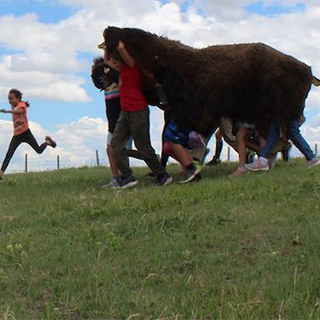Student Spotlight
Landon Magee
Blackfeet Tribal member and graduate of the Wildlife Biology Program in the Franke College of Forestry and Conservation.
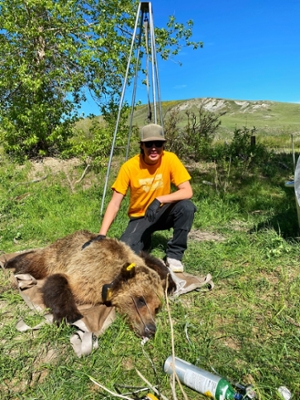 Senior Landon Magee is a bright light in the Franke College of Forestry and Conservation. He has been an outstanding student, mentor, and role model as he has progressed through the Wildlife Biology Program here in the Franke College of Forestry and Conservation at the University of Montana. Landon and I began talking about his interest in the Wildlife Biology graduate program early in his undergraduate career and we met with Wildlife Biology Program Director, Chad Bishop, Professor Mike Mitchell, and Gerald “Buzz” Cobell of the Blackfeet Nation Fish and Wildlife Department, to begin brainstorming possible research projects that would both benefit the Tribe and Landon’s thesis work. Landon is a focused and determined student as well as a kind and giving young man. Landon has been an academic standout as a member of the Davidson Honors College and has been recognized on the Dean’s List and the President’s 4.0 List. Landon recently talked with me about his home, his interest in Wildlife Biology and his journey to the University of Montana.
Senior Landon Magee is a bright light in the Franke College of Forestry and Conservation. He has been an outstanding student, mentor, and role model as he has progressed through the Wildlife Biology Program here in the Franke College of Forestry and Conservation at the University of Montana. Landon and I began talking about his interest in the Wildlife Biology graduate program early in his undergraduate career and we met with Wildlife Biology Program Director, Chad Bishop, Professor Mike Mitchell, and Gerald “Buzz” Cobell of the Blackfeet Nation Fish and Wildlife Department, to begin brainstorming possible research projects that would both benefit the Tribe and Landon’s thesis work. Landon is a focused and determined student as well as a kind and giving young man. Landon has been an academic standout as a member of the Davidson Honors College and has been recognized on the Dean’s List and the President’s 4.0 List. Landon recently talked with me about his home, his interest in Wildlife Biology and his journey to the University of Montana.
Can you share a little bit about where you grew up and what you appreciate about the place?
I grew up in Browning, MT at the heart of the Blackfeet Reservation. It is a small Native American community, so everyone pretty much knows everybody. One of the things I appreciate most about my community is the environment. The wildlife here are plentiful and the scenery is beautiful. You get a mix of glaciers and mountains, as well as the rivers and creeks that cut through the rolling hills and plains.
When and how did your interest in Wildlife Biology begin?
My interest in Wildlife Biology really began in high school when I really had to decide what I wanted to do in college. However, my interest in wildlife has always been there. I grew up outside of Browning in the country where there was not much to do other than explore the outdoors. In my outdoor endeavors, I became quite fond of all the living things and it just always amazed me how everything worked. I also began hunting at quite a young age, which is when I really developed an appreciation for wildlife. Moreover, while engaging with the hunting community, I tended to notice the problems wildlife face and the problems many of the people mentioned. I understood that through wildlife biology, I could develop the knowledge necessary to come back and fix these problems for the benefit of the wildlife and my people.
Can you talk about the summer work you have been doing for the last couple of years?
For the previous two summers, I have worked for the Blackfeet Fish and Game Department as a wildlife technician. My job mostly involved handling bear problems and nuisances, whether that be livestock depredations, bears getting into residential and recreations areas, and other human-bear conflicts. Through the Fish and Wildlife Service, we were also required to capture, collar, and monitor grizzly bears. So, I was able to handle a grizzly bear while it was sedated. Before that, I received a HOPA Mountain Native Science Fellowship. Through this fellowship and working with Dr. Scott Mills, I was able to design my own study that examined the presence and absence of white-tailed jackrabbits on the Blackfeet Reservation through camera trapping and driving transects.
What brought you to the University of Montana?
It’s actually a funny story. So, I have always been a huge Montana State Bobcats fan. For the longest time I always figured that is where I would end up going to school. However, upon applying for college, I realized the University of Montana had the number one ranked Wildlife Biology program in the nation, so I chose what was best for my academics.
Did you have a favorite class? Favorite instructor?
I think all the instructors I had were great! They all contributed so much to my education and future. Two instructors really stood out to me however because of how much I enjoyed the classes they taught. My two favorite classes, taught by Dr. Doug Emlen, were Genetics and Evolution and Behavior and Evolution. I also really enjoyed the Infectious Diseases and Conservation of Wildlife Populations classes taught by Dr. Angela Luis.
What did you like about the Wildlife Biology program?
The Wildlife Biology program is great through and through. There is not one negative thing I have to say about it. They offered so many opportunities to learn, the classes and instructors were excellent, and the curriculum provided for opportunities to gain hands on experience outside of the textbooks.
What is next for you?
I plan on continuing my education through the University of Montana’s graduate school to receive my Master’s in Wildlife Biology. Once I complete my education, I plan on moving back home to work for the Blackfeet Fish and Wildlife Department as their biologist, where I hope to gain some valuable professional work experience and contribute to the environment that my ancestors once depended on.
Can you talk about the work that you will be doing for your master’s research?
The focus of my Master’s research will be studying big game populations on the Blackfeet Reservation. I do not have a set-in-stone project yet, but I hope to be able to study elk, especially in relation to the intense fragmentation of elk habitat that the reservation is experiencing.
What are your goals following graduate school?
I plan to move back home and become the first enrolled tribal biologist for the Blackfeet Tribe. Here I hope to develop many projects that will allow the tribe to have baseline biological data for a variety of species, especially big game and predator populations.
What advice do you have for new students in the Wildlife Biology program?
I would advise new students to be on the lookout for internship and field work opportunities. These opportunities are not only fun and exciting as it allows you to get outside of the classroom, but they also allow you to learn some really valuable knowledge and skills that you don’t always learn in the classroom. Not to mention, they are also great resume boosters.
Congratulations, Landon!
Jordan Jimmie
Hydrology Graduate Student
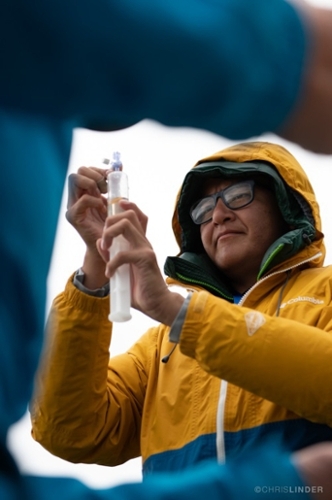 By Jennifer Harrington, Native American Natural Resources Program Coordinator
By Jennifer Harrington, Native American Natural Resources Program Coordinator
Jordan Jimmie is a master’s student in the Forestry program in the W.A. Franke College of Forestry and Conservation at the University of Montana. Jordan is currently working with the Confederated Salish and Kootenai Tribes (CSKT) to model the impact of water delivery on the Flathead Reservation if the CSKT Water Compact is passed or not passed by the United States Senate. His graduate work is titled, "Modeling Hydrologic Impacts of Water Rights Quantification and Settlement on the Flathead Indian Irrigation Project."
Jordan is a Sloan Fellow and a fellow in the UM BRIDGES NSF Research Traineeship Program, which supports graduate student research at the food-energy-water nexus. Jordan is a proud member of the Navajo Nation (Diné) from Flagstaff, Arizona, and holds a B.S. in environmental hydrology and water resources from the University of Arizona. As an undergrad, Jordan held a variety of impressive research positions including studying cancer emergence from groundwater contamination exposure at UA and studying soil isotopes at the University of Texas Austin. In 2016, Jordan was selected for the prestigious Udall Native American Congressional internship program, through which he served the U.S. House of Representatives Committee on Natural Resources as they debated issues surrounding Native American water rights settlements. Jordan worked over two summers participating in a research expedition in the heart of the Yukon-Kuskokwim (YK) Delta to collect hydrologic field data regarding physical changes in tundra lakes and ponds – data that was later analyzed at the Woods Hole Research Center in Falmouth, Massachusetts. Jordan has a passion for science – particularly hydrology – and education. Through his career, he hopes to use his education to give back to Indian Country and specifically to teach hydrology and STEM education at a tribal college or university.
I first met Jordan over the phone as he was deciding where to apply for graduate school. We talked about the programs offered in the W.A. Franke College of Forestry and Conservation and about the faculty, particularly Brian Chaffin, assistant professor of water policy and governance, who would become Jordan’s advisor. Jordan and I were both fortunate to participate in the Pacific North West (PNW) Cosmos Indigenous Mentoring Program float trip on the Middle Fork of the Salmon River. The program gathered Native American scholars entering a graduate program in one of the participating institutions (including the University of Montana, Montana State University and the University of Idaho) and their respective advisors on a four-day trip. Activities included learning about teepee design and set up with a Nez Perce tribal member and environmental scientist. There were many talking circles, and on the second day the group started a three-day, two-night float on the Middle Fork of the Salmon River. Students and advisors got to know each other and were able to learn about the importance of culture and identity for Native American students and tools for mentoring.
I was able to speak with Jordan over the phone recently to talk about his time at UM and what his plans are after graduation.
What did you think that graduate school would be like when you first began here at UM?
I thought there would be no life outside of graduate school. I thought that it would be difficult to find balance – to eat healthy, to exercise and to go to church. I saw relatives go to grad school and saw things become imbalanced.
What were some of the challenges that you were able to work through in graduate school?
The level of my presentations and how I conduct myself in professional settings. Learning how to distinguish how I speak to friends and how I speak professionally and learning not to mix them, which required practice. I learned to take ownership of my research and to create top-notch research that others could build upon. One of the expectations that I had of graduate school was that all research needed to be life changing. I’ve realized that the research needs to be meaningful but does not need to save the world or be Nobel-worthy to be impactful.
I experienced challenges with faculty that I did not see eye-to-eye with that I eventually learned to coexist with and to work together in a professional setting.
I have had to learn to advocate for myself. Coming to Montana from out-of-state, you better do your best to make sure that everything is covered like housing and financial aid. I experienced issues like being over-awarded and scholarships were sent back and there was misfiled paperwork and a deadline was missed. I tried to advocate for myself and other Native students to make sure that things were getting done.
Did you find that graduate school opened you up to new ways of understanding the world?
On a personal level, I thought about who I decide to spend my time with and how I spend my time. I learned to let go and not worry so much. I learned to say, “This is out of my hands.”
I am an introvert, and I am picky about how I spend my time. If you are going to do something, make it meaningful! I have learned not to limit myself; the sky is the limit. I count my blessings! I am privileged; I have resources as a graduate student that others do not have.
How important was it to include the Confederated Salish and Kootenai Tribes in your research?
Foundational. It was my first thought before entering UM. Working with tribes, it drives you! It reaffirms my commitment to serving Indigenous peoples. I am an Indigenous hydrologist!
It is so important to have representation on all levels, in academia and in the private sector.
How did working with the Tribes influence your research process and your research outcomes?
It is a process. Sovereignty is a real thing! You must build relationships, or you will have a hard time doing your research. Transparency is key! The Confederated Salish and Kootenai Tribes have cultivated the research idea. There were pivotal meetings with Casey Ryan (FCFC graduate in hydrology – 2015 and current CSKT hydrologist) and Seth Makepeace (CSKT hydrologist). The research chosen is a priority, it is relevant, and it is timely for the Tribes. I am fortunate because of the relevance of the 2015 Compact.
The outcomes of this research include learning how to effectively communicate the importance of this project to the Flathead and beyond. I am learning how to be confident about the results. I am interested in presenting it to the Salish Kootenai College, to share my findings with relevant people.
How was the PNW-Cosmos float? Do you feel it helped you connect with your advisor and other students?
The float trip was awesome! I love water in general. A couple of days camping on the Middle Fork of the Salmon River was incredible!
The trip and the activities did make me and Brian, my advisor, closer. It was a little forced in how structured it was, but it allowed me to see him in a new setting, chilling, makes him more personable.
Going through that experience builds camaraderie and strengthens bonds. It was awesome to be around Native peoples and allies to learn together. We were able to share our viewpoint of science, the Indigenous way. It was a good experience!
What student groups have you belonged to?
I am the president of the UM American Indian Science and Engineering Society (AISES). I was a co-chair of the Native American Student Advisory Council (NASAC). I am currently a student senator for the Associated Students of the University of Montana (ASUM). And I am a member of the Missoula community Run Wild Missoula group.
How have the groups influenced your graduate education here at UM? What was a project with student groups that really had an impact on you?
Being active in student groups has had a positive influence on my education. AISES is a struggle. ASUM has been rewarding, seeing the government side of how things are tun. It is important to have representation. There is only me and one other Native American student on Senate. I am learning how to be most effective and I am learning how to advocate for students. There are things that some students have to worry about that I do not. How can I make it meaningful!
What are you plans after you graduate?
I will graduate in a month and defend. I will be starting a PhD program at Oregon State University (OSU) in Water Resources Engineering in the Fall. I have been awarded a Diversity Advancement Fellowship which starts this summer. I will be working with John Selker at OSU.
We wish you all the best, Jordan! It has been wonderful having you here at the University of Montana in the Franke College of Forestry and Conservation!
Miigwech,
Jen Harrington, Director
Native American Natural Resource Program
Franke College of Forestry and Conservation
University of Montana
Kari Eneas
Wildlife Biology Graduate Student
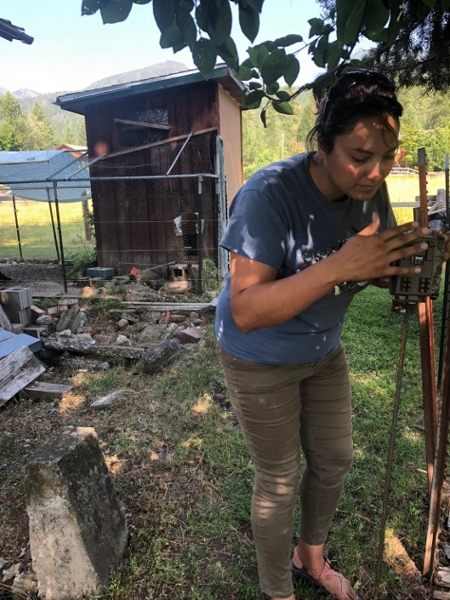 By Jennifer Harrington, Native American Natural Resources Program CoordinatorThesis title: "Influence of livestock and electrified fences on livestock depredation and habitat selection by grizzly bears in the Mission Valley, Montana”As both human and grizzly bear populations continue to increase and expand, the need to address increasing management conflicts and concerns has developed. Wildlife biology master’s student Kari Eneas has worked for the Salish Kootenai Confederated Tribal Wildlife Management Program since 2008 and has worked with bears intermittently throughout that time. Kari’s graduate research was designed to quantify the effectiveness of electric fencing in preventing conflicts between grizzly bears and small-scale poultry and livestock producers. Her aim is to study the regional ecology of bear movements through the landscape in both the absence and presence of electric fences and observe whether fences are adequate at preventing depredation conflicts within the Mission Valley on the Flathead Indian Reservation.
By Jennifer Harrington, Native American Natural Resources Program CoordinatorThesis title: "Influence of livestock and electrified fences on livestock depredation and habitat selection by grizzly bears in the Mission Valley, Montana”As both human and grizzly bear populations continue to increase and expand, the need to address increasing management conflicts and concerns has developed. Wildlife biology master’s student Kari Eneas has worked for the Salish Kootenai Confederated Tribal Wildlife Management Program since 2008 and has worked with bears intermittently throughout that time. Kari’s graduate research was designed to quantify the effectiveness of electric fencing in preventing conflicts between grizzly bears and small-scale poultry and livestock producers. Her aim is to study the regional ecology of bear movements through the landscape in both the absence and presence of electric fences and observe whether fences are adequate at preventing depredation conflicts within the Mission Valley on the Flathead Indian Reservation.
In a previous field season, Kari was part of a biologist crew that trapped and collared grizzly bears for these analyses. She also interviewed landowners, farmers and ranchers throughout the valley about grizzlies, electric fencing and small livestock. Based on these discussions, multiple sites were selected, and electric fences were installed around pig, chicken, goat and llama paddocks and enclosures. Each site was set up with two research cameras that are being used to monitor bear behavior near electric fences by recording interactions of the bears with fences.
Kari will earn her master’s in Fish and Wildlife Biology from the University of Montana this spring. I recently to spoke with Kari to talk about her time at UM and what her plans are after graduation.
What did you think that graduate school would be like when you first began here at UM?
I thought that graduate school would be hard work, tough – the general framework to designing and conducting research. What I found surprising was that the Wildlife Biology Program is signing up for a job. The classes frame what I am here to do, and I have also been taught skills to do the job. It has made it exciting. I am passionate about my job!
Going into graduate school, I had a project with a specific advisor, and I had committee members in place and the classes needed to develop tools to complete the project. That all helped me streamline my education.
What were some of the challenges that you were able to work through in graduate school?
My biggest obstacles were my priorities when I first began school. I was focused heavily on getting good grades, so much so that I lost sight of what the courses were providing me, and after guidance and conversations with my advisor and committee, I realized that the classes are assisting me with my overall research project. I stopped putting so much emphasis on my grades and instead put my focus on learning the tools to complete the project.
Other challenges have been learning how to come out of my shell. I commute three times a week so that made it challenging to make connections and relationships here on campus. There was a shift in my mind when I realized that I had become part of the UM community! It has been a good journey here, very rewarding!
Did you find that graduate school opened you up to new ways of understanding the world?
I have appreciated being able to take management issues and concerns and turn them into ecological concepts and research questions. I think about work from a different lens now.
How important was it to include the Confederated Salish and Kootenai Tribes in your research? How did that influence your research process and your research outcomes?
It has been important to include the Tribes in my research! I grew up here. This is my home! My career with the CSKT Wildlife Management Program has spanned 11 years, and it was important that the research I did would benefit the Wildlife Program and my Tribe! It took four to five years to flush out a research project that would address management concerns and would link to an available advisor. It was important to take that extra time to find the right project that would benefit both the Wildlife Program and the Tribes. My project has direct effects on the reservation in terms of learning how to coexist with grizzly bears.
What student groups have you belonged to?
I have two advisors and with labs that meet regularly and I am a Sloan Fellow, and we meet on campus once a month. It is community time. It really helps to have another level of community, to hear other stories, trials and obstacles, all in different departments on campus. Having familiar faces on campus really helps me feel connected! During this time when we are working remotely, it has been important to meet with the Sloan group and my labs because seeing their faces and hearing their stories helped with feelings of isolation.
What are your plans after you graduate?
I defend on Friday, April 17, 2020! I am already working on field season preparation for work. We will be conducting bird surveys. I will continue to work with grizzly bear management and conflict. My graduate education has prepared me for my next chapter at work. Last summer I hosted a series of community meetings on grizzly and large mammal management. We are working to network with other non-profit organizations to engage with the community. We had participants practice spraying bear spray so that it is incorporated into their muscle memory, and we talked a lot about grizzlies. The goal is to educate, to engage and to help create a coexistence with bears.
We wish you the very best, Kari!! Thank you for being a valuable member of the University of Montana Franke College of Forestry and Conservation team!
Cynthia Coleman
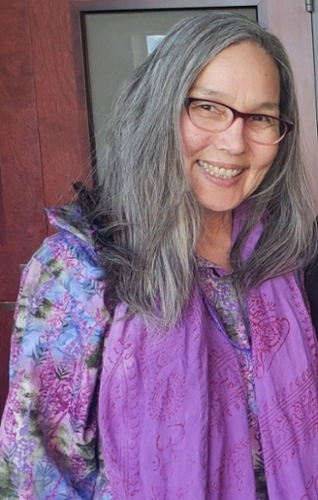 Cynthia Coleman, Resource Conservation MS student and BRIDGES trainee, is a recipient of the Native Agriculture and Food Systems Scholarship. This $1,000.00 scholarship is provided by First Nations Development Institute.
Cynthia Coleman, Resource Conservation MS student and BRIDGES trainee, is a recipient of the Native Agriculture and Food Systems Scholarship. This $1,000.00 scholarship is provided by First Nations Development Institute.
First Nations created this scholarship program to encourage more Native American college students to enter agriculture and agricultural-related fields so that they can better assist their communities in reclaiming control over local food systems.
First Nations Development Institute are encouraged and impressed by Cynthia’s academic achievements and goals, which exemplify the future of food systems work in Indian Country.
Mateen Hessami
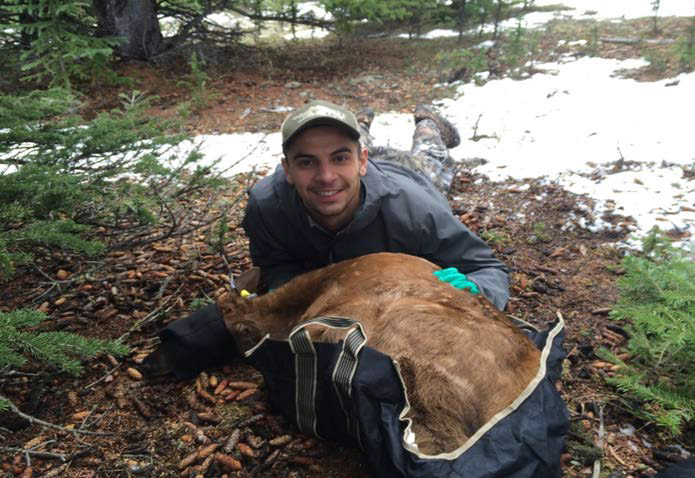 Mateen has spent his past summers working as a technician on Mark Hebblewhite’s long-term NSF funded elk-predator project outside of Banff, Alberta. He has assisted on calf captures, vegetation surveys, cause-specific mortality investigation, herd demographic observations, and wolf cluster work. In his senior thesis project, Mateen deployed, funded, maintained, and serviced independently, 27 remote cameras. He is examining recruitment rates in elk and comparing traditional field estimates of calf:cow ratios with estimates derived from remote cameras.
Mateen has spent his past summers working as a technician on Mark Hebblewhite’s long-term NSF funded elk-predator project outside of Banff, Alberta. He has assisted on calf captures, vegetation surveys, cause-specific mortality investigation, herd demographic observations, and wolf cluster work. In his senior thesis project, Mateen deployed, funded, maintained, and serviced independently, 27 remote cameras. He is examining recruitment rates in elk and comparing traditional field estimates of calf:cow ratios with estimates derived from remote cameras.
Payton Adams
Payton Adams is a wildlife biology major and earned a minor in wilderness studies through the Wilderness and Civilization program. Payton is from Ronan, Montana on the Flathead Indian Reservation. He is an enrolled member of the Confederated Salish and Kootenai Tribes (CSKT) but is also Little Shell Chippewa and Northern European. He has always felt most comfortable in nature, hiking, fishing and camping, especially in the Mission Mountains. Payton’s first bit of exposure to a career in natural resources came as a sophomore in high school when he was hired by the Youth Conservation Corps. He spent a summer working at a fish hatchery, transporting swans for reintroduction and participating in a Western fence lizard count.
He originally began his college career as a civil engineering major at a different university, but quickly realized his passion for working outdoors and transferred to the University of Montana. During his first summer in Missoula, he was hired as a technician with the CSKT Wildlife Management Program. He continued this position for four years, working in the summer and during winter breaks. He has also worked with Dr. Scott Mills’ on a long-term snowshoe hare study. Payton was also created his own outreach project teaching high school students from his reservation about trail cameras to introduce them to careers in natural resources. After graduation, Payton will continue his work for the CSKT Wildlife Management Program as a wildlife biologist in training until he completes graduate school.
